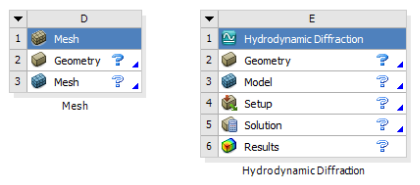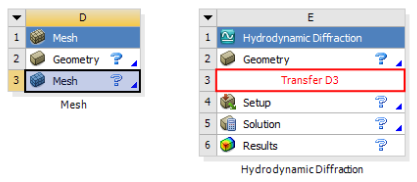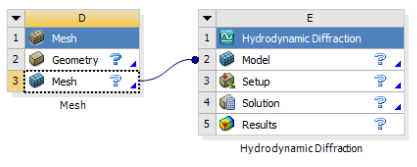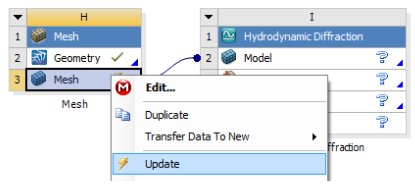Hydrodynamic Diffraction systems can be standalone systems, or attached to an upstream mesh system, depending on the analysis workflow. In the external meshing workflow, the Hydrodynamic Diffraction system shares the Mesh of the Mesh system with the Model of the Hydrodynamic Diffraction system.
To share these systems in the Project Schematic, you must initially create two independent systems, then manually link the two relevant cells. The cell list updates once the link has been established.
| Create Mesh and Hydrodynamic Diffraction systems in the Project Schematic |
 |
| Manually link the Mesh cell to the Model cell |
 |
| Hydrodynamic Diffraction system updates to reflect the connection |
 |
| After the geometry has been imported and the mesh is generated, update the Mesh cell from the Project Schematic |
 |
There are two analysis options for a Hydrodynamic Diffraction analysis: either to calculate the Hydrostatics only (Aqwa stages 1 and 2), or to calculate the full Hydrodynamic results.
When the full hydrodynamic diffraction analysis is performed, Aqwa generates a database of hydrodynamic coefficients for each structure (or group of interacting structures) in the model. Generating this database is often the most computationally expensive part of the hydrodynamic workflow. Motion response amplitude operators (RAOs) and force/moment quadratic transfer functions (QTFs) are included in the database. These are derived from Aqwa's calculations of the first-order wave loads, frequency-dependent added mass, and radiation damping matrices.
After doing a full Hydrodynamic Diffraction analysis, you may occasionally need to modify a property of the model that affects the RAOs and QTFs, but has no effect on the wave loads or frequency-dependent added mass/radiation damping. For example, you may choose to introduce additional frequency-independent damping to a structure to tune the calculated RAOs to some experimental data. In these cases, the Aqwa Workbench editor re-uses the existing hydrodynamic database as much as possible to reduce the computational cost of re-solving the hydrodynamic diffraction analysis. A notification appears in the Messages panel to indicate when this has happened.


